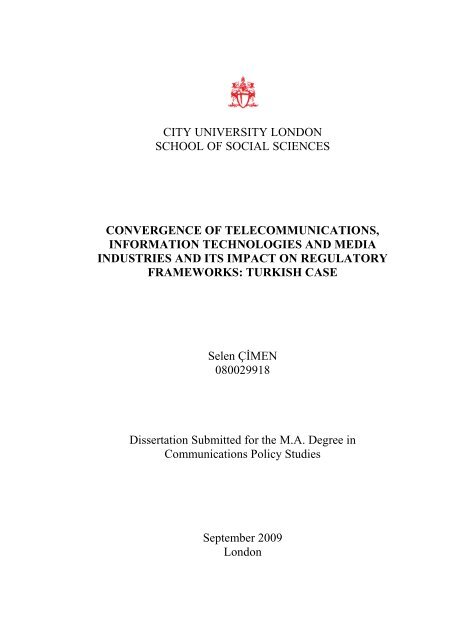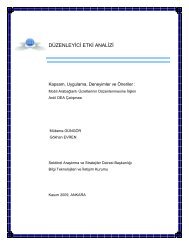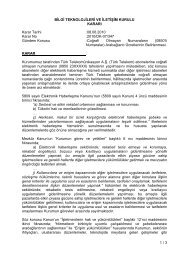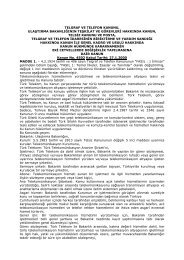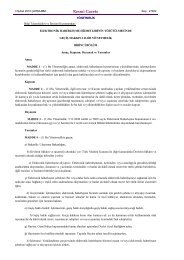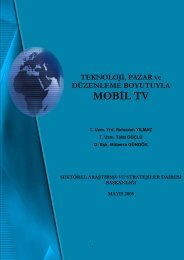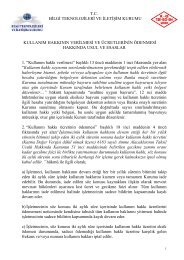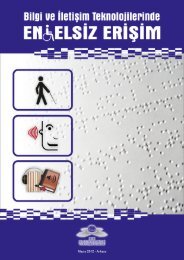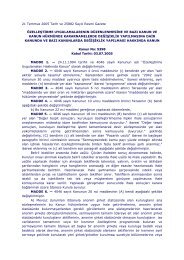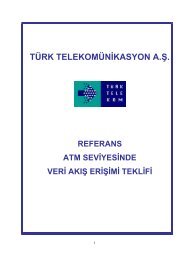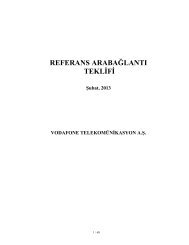city university london school of social sciences convergence of ...
city university london school of social sciences convergence of ...
city university london school of social sciences convergence of ...
You also want an ePaper? Increase the reach of your titles
YUMPU automatically turns print PDFs into web optimized ePapers that Google loves.
ABBREVIATIONSCA: Competition Authority (<strong>of</strong> Turkey)EC: European CommissionEU: European UnionGDP: Gross Domestic ProductICT: Information Communication TechnologiesICTA : Information and Communication TechnologiesAuthorityIPTV: Internet Protocol TelevisionIT: Information TechnologiesITU: International Telecommunications UnionOFCOM: Office <strong>of</strong> CommunicationsOECD : Organization for Economic Cooperation andDevelopmentRTSB: Radio and Television Supreme BoardTA: Telecommunications Authority (<strong>of</strong> Turkey)TRT: Turkish Radio Television CorporationTT: Turk TelekomVoIP: Voice over Internet Protocol4
different policy objectives‟ (p.30).It is a fact that once separated regulatory principals must also converge or a totallynew regulatory framework must be adapted to cover all communications industries,whether the <strong>convergence</strong> between telecommunications, information technologies andmedia industries takes place because <strong>of</strong> technological developments or politicaldecisions. Then the question arises: „How different should regulation to be to dealwith <strong>convergence</strong>? Any regulation aims at achieving both the efficient allocation <strong>of</strong>resources and public interest goals (Clements: 1998, Kiessling and Blondeel: 1998).Even in a convergent environment, these goals will remain vital. To achieve thesegoals the regulator will need to provide potential participants and investors, as wellas users, with an environment that has some legal certainty (Clements: 1998, p.203).The current regulatory framework is being challenged by <strong>convergence</strong> and manyissues have already been raised that need to be resolved. Given the transition <strong>of</strong> themarket structure, policy makers and regulators would need to handle those issues <strong>of</strong>fair competition, licensing and public interest goals‟ (Hukill et.al: 2000, p.298-299).The need to introduce legal frameworks and regulations to regulate aspects <strong>of</strong><strong>convergence</strong> through a flexible and technology neutrality approach moved someregulators around the world to restructure their regulatory agencies towards anintegrated information and communication technology regulator. For example,OFCOM (Office <strong>of</strong> Communications) was established in 2003 by integration <strong>of</strong> fiveseparate regulatory agencies in UK, also telecommunications and broadcastingregulatory authorities are integrated and new communications authorities areestablished both in Hong Kong and Australia. Besides the integration <strong>of</strong> existingregulatory authorities, also some countries readjusted their broadcasting andtelecommunications authorities‟ field <strong>of</strong> work taking into account <strong>convergence</strong> suchas France.This study focuses on <strong>convergence</strong> <strong>of</strong> telecommunications, information technologiesand media industries with a regulatory point <strong>of</strong> view. As it is explained in depthbelow, a case study regarding Turkey is done and some regulatory proposals arederived in order to deal with the challenges posed by <strong>convergence</strong> and regulate6
aspects <strong>of</strong> <strong>convergence</strong> in the country.1.1. Aim <strong>of</strong> the StudyThis study aims to provide in depth information regarding <strong>convergence</strong> ontelecommunications, information technologies and media industries and itsregulatory effects. It overlooks and critically assesses the technical and economicaspects <strong>of</strong> the concept together with <strong>social</strong> and cultural ones. Since <strong>convergence</strong>blurs the boundaries between these sectors that used to be regulated separatelybefore, it brings some regulatory challenges. When considered from this point <strong>of</strong>view, <strong>convergence</strong> brings some challenges on regulatory frameworks to overcome.Besides the general conceptual information, the study includes a case study regardingTurkey and derives some regulatory proposals taking into account the structure andthe current regulatory framework in the country.1.2. Research QuestionsMain research questions that are answered in the study are as follows:1. What are the effects <strong>of</strong> <strong>convergence</strong> on regulatory frameworks? Is there a need fora change in regulatory frameworks taking <strong>convergence</strong> into account?The answer <strong>of</strong> this question includes the analyze <strong>of</strong> different aspects <strong>of</strong> <strong>convergence</strong>from regulatory point <strong>of</strong> view. First, <strong>convergence</strong> in different levels is scrutinized inorder to better understand the concept. Besides technical and economic aspects, alsosocietal effects <strong>of</strong> <strong>convergence</strong> are examined in order to have an understandingregarding <strong>social</strong> aspect <strong>of</strong> the concept. By examining mentioned effects, it is tried tobe answered whether there is a need for change in regulatory frameworks or not.2. What is primary overall outcome <strong>of</strong> an organizational regulatory unification inTurkey?Since the outcome <strong>of</strong> constructing a converged regulator depends on the specificcircumstances and the ways in which the unified organization is constructed, in orderto answer this question, current regulatory situation in the country is scrutinizedtaking into account the structure and scope <strong>of</strong> separate regulatory bodies in the7
country. The possible outcomes <strong>of</strong> a converged communications regulator areanalyzed and the situation is put forthin order to answer this question and results are used to derive some regulatoryproposals.3. How should a converged regulatory body be constructed in Turkey?In order to answer this question, the recommendations <strong>of</strong> regional and internationalbodies are taken into account. In light <strong>of</strong> the analysis regarding current situation anddefects <strong>of</strong> markets and regulatory frameworks, recommendations are derived abouthow to form a converged regulatory body.1.3. Structure and MethodologyLooking at the structure <strong>of</strong> the study; following the introduction part, Part 2 detailsthe concept <strong>of</strong> <strong>convergence</strong> by reviewing the related literature. The main drivers thatlead to <strong>convergence</strong> <strong>of</strong> telecommunications, information technologies andbroadcasting sectors are reviewed in this part. Also, <strong>convergence</strong> is assessed from aregulatory point <strong>of</strong> view taking into account societal importance <strong>of</strong> regulation. In thiscontext, universal service and public service considerations in a convergingenvironment are assessed together with regulation‟s effects on consumers, quality <strong>of</strong>service, security, privacy and intellectual property rights issues.As <strong>convergence</strong> is an international phenomenon, the views <strong>of</strong> internationalorganisations are important and Part 3 details the approaches <strong>of</strong> some internationaland regional organizations to <strong>convergence</strong>. International Telecommunications Union(ITU), Organization for Economic Co-operation and Development (OECD) andEuropean Commission‟s (EC) approaches to <strong>convergence</strong> are analyzed.The measures needed in order to deal with regulatory challenges in a convergingenvironment are put forth in the study in order to answer the research questions.While doing this, the process towards a converged policy framework in one <strong>of</strong> themost successful countries across Europe in terms <strong>of</strong> <strong>convergence</strong> efforts is alsoelucidated. In this context, some aspects <strong>of</strong> the communications regulatory8
framework in UK are put forth taking into account <strong>convergence</strong> in Part 4.After the basis that is set in these chapters, the research part takes place in Part 5.This chapter concentrates on Turkish case. In order to answer the second and thethird research questions, first both the legal and administrative structure in thecountry is analyzed. While analyzing the appropriate form and role <strong>of</strong> a newconverged body, recommendations and policies that are developed by abovementioned international and regional bodies are also considered. Then, in the light <strong>of</strong>this analyze some regulatory proposals are derived for the country.Finally, Part 6 summarizes the study and puts forth the important points that arereached during the research.Regarding the methodology; qualitative research strategy and case studymethodology are used in this particular study. Data is gathered using secondarysources <strong>of</strong> literature such as <strong>of</strong>ficial documents from regulatory and governmentalbodies. Articles from academic journals are used as well as academic books and<strong>of</strong>ficial documents <strong>of</strong> EU, ITU, OECD and regulatory reports from countries. Inorder to analyze the situation in Turkey and answer second and third researchquestions, individual case study methodology, which may be understood as „theintensive study <strong>of</strong> a single case where the purpose <strong>of</strong> that study is –at least in part- toshed light on a larger class <strong>of</strong> cases‟ (Gerring: 2007, p.20) is used in Part 5. Thismethodology is chosen in order to pursue in-depth analysis and to study whole units<strong>of</strong> the issue rather than some aspects <strong>of</strong> units. As stated by Gerring (2007, p.68),„evidence for a case study may be drawn from an existing dataset or set <strong>of</strong> texts ormay be product <strong>of</strong> original research by the investigator‟. In this particular study, amixture <strong>of</strong> these two methods is used. Current structure, duties and responsibilities <strong>of</strong>regulatory agencies and boundaries between them are put forth by analyzingsecondary resources.9
2. CONVERGENCE AND ITS REGULATORY EFFECTS2.1. Concept <strong>of</strong> ConvergenceThe process <strong>of</strong> <strong>convergence</strong> was first mentioned in the academic literature in the1970‟s. One <strong>of</strong> the earliest expressions <strong>of</strong> the idea came from Nicholas Negropontein 1978. „He used three overlapping circles to represent the technologies <strong>of</strong>computing, printing, and broadcasting. The most rapid growth and innovation, heargued, could be found in the area where the three intersected. Negroponte hadoverlooked the telephone system, but simultaneously, telecommunications‟(Mueler:1999 p.12).After its first usage in the literature, many colleagues attempted to define the termbut there is not a commonly accepted definition <strong>of</strong> the <strong>convergence</strong> in the literature.According to Lind (2004), „it was not just the business community who embraced<strong>convergence</strong> without reflecting about how to define the term or its deeper meaningand implications. Most academic articles the last decade mentioning <strong>convergence</strong>have taken it as a given and just dealt with different implications <strong>of</strong> the phenomena.Almost no academic articles have tried to define <strong>convergence</strong> and relate it to atheoretical framework‟ (p.2).EC‟s „Green Paper on the Convergence <strong>of</strong> the Telecommunications, Media andInformation Technology Sectors, and the Implications for Regulation‟ (Green Paper)which is the most quoted source for definition <strong>of</strong> <strong>convergence</strong>, defines the term as:„the ability <strong>of</strong> different network platforms to carry essentially similar kinds <strong>of</strong>services, or the coming together <strong>of</strong> consumer devices such as the telephone,television and personal computer‟ (EC:1997, p.1).In most <strong>of</strong> the definitions <strong>of</strong> the term, its characteristic is emphasized to “blur theboundaries”. For example, OECD has defined <strong>convergence</strong> as a buzzword in theinformation industry „which blurs the technical and regulatory boundaries betweensectors <strong>of</strong> economy‟ OECD:1992, p.13). Similarly, Fransman (2000) defines<strong>convergence</strong> as „the blurring <strong>of</strong> borders between telecoms, computing and media‟(p.39). Choi and Valikangas (2001) similarly defines the term as the blurring <strong>of</strong>10
oundaries between industries by the <strong>convergence</strong> <strong>of</strong> value propositions,technologies and markets (p.426). Also, according to Bauer et al. (2003) <strong>convergence</strong>means „processes that blur the boundaries and/or reduce the differences betweenactivities, industries, nations and regions‟ (cited in Hacklin:2008, p.2)Convergence can also be defined as a figure, where different sectors move into eachother and constitute a new converged entity after <strong>convergence</strong>. Figure 1 representsthe sectors that converge and constitute one single entity.Figure 2.1:industriesIllustration <strong>of</strong> <strong>convergence</strong> <strong>of</strong> telecommunications, media and ITYpsilanti and Xavier (1998) state that, „<strong>convergence</strong> is not only a technologicalphenomenon, but includes services and therefore markets‟ (p.644). Since, it ispossible to define the term in different ways in terms <strong>of</strong> technology, services,markets or regulation, the definitions <strong>of</strong> the term show variety. As a concept havingthat many dimensions, several different types <strong>of</strong> <strong>convergence</strong> is defined in theliterature. For example; in its Green Paper, EC defines <strong>convergence</strong> on four differentlevels which are namely: technology and network platforms, industry alliancesand mergers, services and markets and finally policy and regulation. (EC:1997,p.2)11
„Another example is the report from the Swedish government ConvergenceCommission (SOU 1999:55 cited in Lind:2004). The report defines four types <strong>of</strong><strong>convergence</strong>. Network Convergence happens when separate physical infrastructurescan carry all types <strong>of</strong> services. Service Convergence is the process when theboundaries between communication services and content services are lowered andthe two separate service classes converge into one. Appliance Convergence is theprocess when user gadgets and terminals embrace new functionality and eventuallycan be used for all purposes. Market Convergence is defined as the consequence <strong>of</strong>the three other kinds <strong>of</strong> <strong>convergence</strong> and means that market players can enter newindustries when network, appliance or service <strong>convergence</strong> makes that possible‟[emphasis not in original] (Lind:2004, p.3-4).Skogerbø (1997) also proposes a definition which emphasizes the different types <strong>of</strong><strong>convergence</strong>, namely network, service and market <strong>convergence</strong>.„Network Convergence: Different network platforms provide seamlessinterconnection and allow for the distribution <strong>of</strong> any kind <strong>of</strong> serviceTerminal Convergence: Equipment may be used to access different networkplatforms, and/or they may be used for a wide range <strong>of</strong> services across differentplatformsService Convergence: Different services adopt the others format or same servicesare provided in different formats, e.g., as films, books, or multimedia servicesMarket Convergence: Because <strong>of</strong> these other kinds <strong>of</strong> <strong>convergence</strong>, the actorsproviding the different platforms and media are becoming intermixed‟ [emphasis notin original] (Jansen and Nielsen:2005 p.80).Similarly, Tarjanne (2000) states that „<strong>convergence</strong> has been argued to take place ondifferent levels: on the technology, industry and service levels: on the technologylevel, thanks to digitalization, different networks and devices can perform similarfunctions. Technology <strong>convergence</strong> enables traditionally separate sectors to enterinto each other‟s domains. Digitalization allows satellite, wireless, microwave, cableTV networks and telephone lines to be interconnected into one overall system. Thiswill make combined services possible‟ [emphasis not in original] (Tarjanne:2000,12
p.40).Like Tarjanne, also Iosifidis (2002) claims that „<strong>convergence</strong> […] can be present atthree different, although interrelated levels: the technological level (mainly due todigitization <strong>of</strong> broadcasting, IT and telecommunications networks), the structurallevel (as a consequence <strong>of</strong> corporate alliances across different sectors), and theservices and markets level’ [emphasis not in original] (Iosifidis:2002, p.28).It can be easily seen that it is hard to find one common definition or classification <strong>of</strong>the concept in the literature. Some <strong>of</strong> the definitions concentrate on the technologicalside <strong>of</strong> the concept whereas some others highlight the <strong>convergence</strong> <strong>of</strong> markets andservices. It would be helpful to define the reasons that lead to <strong>convergence</strong> in orderto provide a better understanding <strong>of</strong> the concept and its dimensions. Thus, nextsection concentrates on drivers <strong>of</strong> <strong>convergence</strong>.2.2. Key Drivers <strong>of</strong> ConvergenceAs it is not possible to find a generic definition <strong>of</strong> <strong>convergence</strong> in the literature, thereare different opinions regarding the drivers <strong>of</strong> the concept as well. But it is possibleto say that technological change is considered as main driving force <strong>of</strong> <strong>convergence</strong>.(OECD:1992, p.13) Also, Blackman (1998) emphasizes the role <strong>of</strong> the technologicaladvancements and states that, advanced digital technologies allow the manipulation<strong>of</strong> all forms <strong>of</strong> information across all types <strong>of</strong> network and digital compressionabolishes the constraints <strong>of</strong> the past (p.164). Similarly, Ayish (2003) states that„digitalisation is the major driver, but far from being the only factor, which can make<strong>convergence</strong> happen‟ (p.78). Melody et. al (2003) explain the role <strong>of</strong> digitalisationas an enabler <strong>of</strong> „new possibilities for development and creation <strong>of</strong> services withinand beyond the framework <strong>of</strong> traditional communication sectors‟ and they alsohighlight the role <strong>of</strong> computerization as a driver <strong>of</strong> <strong>convergence</strong>, besidesdigitalization (p.28). Shin (2005) also emphasizes the importance <strong>of</strong> internet onacceleration <strong>of</strong> <strong>convergence</strong> besides developments in digital technology. Mueler(1999) analyzes <strong>convergence</strong> as a combination <strong>of</strong> two factors and states that also theadoption <strong>of</strong> common protocols and standards are important besides technologicaladvancements. According to Mueler, „raw technological power is only part <strong>of</strong> the13
<strong>convergence</strong> story. Often overlooked is the fact that digital <strong>convergence</strong> also impliesa process <strong>of</strong> settling upon common protocols and technical standards for datainterchanges. This is a predominantly socio-economic process, not a technical one. Itinvolves the coordinated adoption <strong>of</strong> compatible technology platforms by a criticalmass <strong>of</strong> producers and consumers. That process is affected by network externalitiesand product life cycles. So, in many ways, the progress <strong>of</strong> digital <strong>convergence</strong> is astory <strong>of</strong> the rise and fall <strong>of</strong> specific standards that were designed to bring togethervarious media forms‟ (p.12-14). Similar to this view, Nystrom and Hacklin (2005)emphasize the importance <strong>of</strong> socio-economic drivers including the opinions andreactions <strong>of</strong> end-users. According to them, technological change –specificallyinternet and digitalization- together with liberalization <strong>of</strong> telecommunicationsmarkets is the foremost driver <strong>of</strong> <strong>convergence</strong>. They also state that „regulation hasadopted in favorable ways, enabling the process <strong>of</strong> <strong>convergence</strong> to move on intodifferent corners <strong>of</strong> our economy‟ (p.4).2.3. Convergence from a Regulatory Point <strong>of</strong> ViewWhile analyzing <strong>convergence</strong> from a regulatory point <strong>of</strong> view, it is useful to have alook at the situation in the past in order to provide a better understanding <strong>of</strong> theregulatory situation. Part 2.3.1. briefly explains the situation in the past and rightafter that, Part 2.3.2. explains the regulatory characteristics <strong>of</strong> the converging sectorsbefore Part 2.3.3. analysis the reasons <strong>of</strong> need for a new regulatory policy forconverging sectors and Part 2.3.4. puts forth societal importance <strong>of</strong> <strong>convergence</strong> andits regulation.2.3.1. The Situation in the PastAs Blackman (1998) summarizes; „in the past, communications networks weredesigned to carry different types <strong>of</strong> information separately. Telephone networks weredesigned for voice, broadcast networks for video and so on. Individuals have beenrestricted to either communicating with each other via telephone or to watching,listening to broadcast programming‟ (p.164). But with the emergence <strong>of</strong><strong>convergence</strong>, this traditional separation has disappeared and new services likeInternet Protocol Television (IPTV), Voice over Internet Protocol (VoIP) or digitalbroadcasting have emerged that carry the characteristics <strong>of</strong> both telecommunications14
and broadcasting sectors. The blurring <strong>of</strong> boundaries between these sectors has posedsome challenges in terms <strong>of</strong> policy. In order to understand these challenges better,first the regulatory characteristics <strong>of</strong> converging sectors are explored in the nextsection.2.3.2. The Regulatory Characteristics <strong>of</strong> Converging SectorsAs it is stated briefly in the introduction part, information technologies, media andtelecommunications sectors have different regulatory structures stemming fromdifferent characteristics <strong>of</strong> each sector.Telecommunications industry is subject to sector specific regulation. Regulators areexpected to „provide constant monitoring, arbitration, legal guidelines and a levelplaying field for all. Regulations are required that control operators, provide themwith frameworks for operation and ensure that the interests <strong>of</strong> operators andconsumers are protected‟ (Murdock 1990 cited in Gardner: 2003 p.104).„Broadcasting, especially television, is <strong>of</strong>ten viewed as the most pervasive form <strong>of</strong>media. It can influence the manner in which we receive the information that we needfor entertainment, to keep informed and information to fulfil our obligations ascitizens. Broadcasting also <strong>of</strong>fers the most accessible cultural experience for the bulk<strong>of</strong> the population‟ (OECD:2004 p.10). „The principles and objectives behind mediaregulation include defining and protecting values such as freedom <strong>of</strong> expression andaccess to information, and balancing these with acceptable limitations, such asprotection <strong>of</strong> minors, rights to privacy and personal integrity, and conceptions <strong>of</strong>public service and fair competition as Noveck, McGougan, Gibbons and Tonguedetail‟ (Marsden and Verhulst:2000 p.7). As it can easily be seen, different fromtelecommunications sector, broadcasting sector is subject to content regulation inorder to provide pluralism, diversity, fairness, and impartiality; <strong>social</strong> responsibility;maintenance <strong>of</strong> high quality programming and <strong>of</strong> cultural and linguistic identity;coverage <strong>of</strong> important events; protection against abuse <strong>of</strong> market power;strengthening national and regional industries; protection <strong>of</strong> consumers; andmaintenance <strong>of</strong> standards in matters <strong>of</strong> violence, sex, taste and decency as stated byMarsden and Verhulst (2000 p.7). Besides, as broadcasting necessitates spectrum15
usage, regulation is also needed in order to encourage efficient use <strong>of</strong> this scarceresource.In comparison with telecommunications and media sectors, the InformationTechnologies sector does not have sector specific regulation tradition, but generalcompetition law applies to this sector.As Xavier and Ypsilanti (1998) state, over time „historical characteristics <strong>of</strong> differentservices and the technological platforms they used to deliver service, have expandedand evolved leaving behind the distinctions that regulators have placed upon them‟(p.650). So the scene between regulators and players in the market has changed andthis necessitates some changes in terms <strong>of</strong> regulation. Next section explores this issueand discusses whether a new regulatory approach is needed.2.3.3. The Need for a New Regulatory ApproachAs it is stated above and highlighted by OECD (2004), the previous regulation <strong>of</strong>electronic communications sectors was based around delivery platforms and „thischaracteristic developed in an analogue environment where delivery platforms wereservice specific‟ (p.18). But with the emergence <strong>of</strong> internet phenomenon and serviceslike digital TV, this separate structure is challenged and the distinctions between thesectors <strong>of</strong> ICT industry became blurred.In the literature, most <strong>of</strong> the researchers highlight the fact that existing regulatoryframework is challenged by <strong>convergence</strong> concept and this necessitates some form <strong>of</strong>intervention. For example, Just and Latzer (2000) claim that, the major challengesstemming from <strong>convergence</strong> resulted because „the industry has already entered themediamatics era while the policy makers still remain anchored in the traditionalseparation between telecommunications and media (audiovisual)‟ (p.396). Theyfurther claim that in this situation, the criteria used to categorize the new services arenot objective anymore and this creates regulatory problems that can lead unnecessaryconflict. Since, inapplicable categorizations, combined with divergent regulationsproduce contradictory preconditions for market development, they claim that „it isnecessary to propose an institutional integration <strong>of</strong> telecommunications and media16
Since end users can benefit from more accessible and cheaper services because <strong>of</strong><strong>convergence</strong>, it is commonly agreed that <strong>convergence</strong> is for sake <strong>of</strong> consumers. Inthis regard, Tarjanne (2000) states that <strong>convergence</strong> is good news for end-users. Heindicates that end-users benefit from a widening choice <strong>of</strong> platform-independentservices at decreasing costs. He further claims that, „these should change the way wedo business and live our daily lives. New applications in areas <strong>of</strong> telemedicine,education and electronic commerce, for example should increase the quality <strong>of</strong> lifefor many and transform our society in the same way as electri<strong>city</strong> and telephoneshave done for the past hundred years‟ (p.42). Similar to Tarjanne, Hukill et al. (2000)state that <strong>convergence</strong> spells good news for consumers „as availability <strong>of</strong> servicesincreases even as the services themselves become more affordable‟ (p.303).Regarding the effects <strong>of</strong> <strong>convergence</strong> on consumers, affordability and availabilityissues are also stated by the World Bank (2009). In a recent report <strong>of</strong> the WorldBank, it is indicated that since the prices lower because <strong>of</strong> the <strong>convergence</strong>,consumers‟ access to services expands and this widens coverage by using multipleinfrastructures (p.21). The report also draws attention that ICT users are able toaccess a range <strong>of</strong> services through a wide variety <strong>of</strong> devices because <strong>of</strong> <strong>convergence</strong>(p.24).Besides foremost effects as availability and affordability <strong>of</strong> services, <strong>convergence</strong>also has some less direct effects on end users as stated above. Hukill et al. (2000)note that <strong>convergence</strong> leads continued and renewed interest in developing nationalinformation infrastructures and this development provides introduction <strong>of</strong> newservices even in the countries that have limited service availability. According tothem, development <strong>of</strong> information infrastructure leads a broad range <strong>of</strong> <strong>social</strong> andeconomic activities such as „increasingly efficient business and trade links to bettereducational opportunities‟ (p.303). Furthermore, it is stated by the World Bank(2009) that „<strong>convergence</strong> has an indirect effect on <strong>social</strong> and economic development‟by changing business models, expanding markets, increasing the range <strong>of</strong> services,applications available to users and altering market structure (p.21).22
Also, it is stated by ITU (2002) that „it should also be considered that <strong>convergence</strong>implies an evolution and a possible reduction <strong>of</strong> traditional jobs, while, at the sametime, imposes the development <strong>of</strong> new skills (and consequently the need forspecialized education and training)‟ (p.2). Although this is not a direct effect <strong>of</strong><strong>convergence</strong> on citizens, anyhow this situation affects the people working atconverging industries.While mentioning the effects <strong>of</strong> <strong>convergence</strong> on citizens, it is worth to advert that allcitizens will not benefit from <strong>convergence</strong> because <strong>of</strong> the differences in internetpenetration and computer concentration per household. According to this issue, ITU(2002) states that <strong>convergence</strong> is not going to reach the same level everywhere at thesame time, and even in the most advanced economies, all citizens are not going tobenefit from <strong>convergence</strong> since the beginning (p.2).At this point, it is important to emphasize that the words „consumer‟ and „citizen‟ aredifferent from each other. Consumers buy or use goods and/or services in the market,however citizens participate in society that also includes the market. It can beinterpreted from the definitions that citizen interest already covers the consumerinterest and anything that is for the benefit <strong>of</strong> consumers is already for the benefit <strong>of</strong>citizens. The point that consumer interest and citizen interest are differentiated isexplained by UK government as follows: „The consumer interest referred to aneconomic focus on networks and services, for the benefit <strong>of</strong> individuals; by contrast,the citizen interest referred to a cultural focus on content, for the benefit <strong>of</strong> thecommunity‟ (Livingstone:2008 p.2).When referring to the impact <strong>of</strong> <strong>convergence</strong> on society, different words like „endusers‟, „customers‟, „viewers‟ or „citizens‟ are used in the literature, as it can be seenabove. It can be interpreted that economic issues such as availability andaffordability are more likely to meet the interests <strong>of</strong> consumers whereas <strong>social</strong>benefits <strong>of</strong> <strong>convergence</strong> as advanced information infrastructure and bettereducational opportunities are more likely to meet the interests <strong>of</strong> citizens.To wrap up, <strong>convergence</strong> has many benefits on consumers and citizens as it is stated23
above. In order for them to enjoy these benefits, a proper regulatory framework isimportant which is sensitive to consumer rights, avoids regulatory overlaps,encourages market players to investment and avoids barriers for the development <strong>of</strong>convergent markets.2.3.4.3. Regulation’s Effects on Quality <strong>of</strong> Service, Security, Privacy andIntellectual Property RightsConvergence and its regulation also have some effects on quality <strong>of</strong> service, security,privacy and intellectual property rights issues.When we look at quality <strong>of</strong> service issue, it is possible to examine quality <strong>of</strong> serviceindicators in two different groups as product quality and consumer service quality.Product quality includes applications and network service reliability and quality suchas, voice and video quality, call completion rate, delivery times and reliability <strong>of</strong>messages whilst consumer service quality includes issues such as billing andcomplaints handling.While analysing the effects <strong>of</strong> <strong>convergence</strong> and its regulation on quality <strong>of</strong> service, itwould be a good starting point to express that technological advancements that leadto <strong>convergence</strong>, also enable competition between companies. This has a positiveeffect on quality <strong>of</strong> service especially in terms <strong>of</strong> product quality. So it wouldn‟t bewrong to argue that <strong>convergence</strong> and competition go in parallel and there is highquality <strong>of</strong> service where there is <strong>convergence</strong>. With advanced technology andincreasing competition, there is improvement in technological parameters such aspicture, video sound and voice quality today. When it comes to the second subgroup<strong>of</strong> quality <strong>of</strong> service indicators -consumer service quality- it is <strong>of</strong> crucial importancefor market players to focus on improvement in consumer services keeping in mindthat demand is amongst the important factors that shape converging markets. Thisleads to better results in terms <strong>of</strong> consumer service quality. As it is mentioned above,<strong>convergence</strong> takes place together with competition and competition is another factorthat provides amelioration on quality <strong>of</strong> service. Atubra and Frempong (2001) statethat, competition has potential to lead existing network providers to focus attentionon improvement in consumer service (p.206) and this probably means better quality24
service. Besides, regulators tend to provide a robust consumer protection mechanismtaking into account the converging services environment and this is another factorleading to improvements in consumer service quality. After all, it wouldn‟t be wrongto argue that <strong>convergence</strong> and its regulation have a positive effect on quality <strong>of</strong>service.Convergence is also „introducing new issues that may require regulation, includingsecurity, privacy and consumer protection‟ (Melody et.al.:2003, p.vii). Since itbecomes much easier to transmit information through internet and collectinformation regarding people, privacy protection and its regulation gain importancein a converging environment. It is stated by Henten et.al. (2002) that, consumerprotection is an important issue in a converging environment and „consumers mustbe protected against low quality products, late delivery or pure and simple fraud‟(p.24). As society is becoming more dependent on electronic communicationsnetworks and services, it is important for regulators to constitute a regulatoryframework addressing security and privacy problems in order to protect consumersand citizens.Intellectual property rights constitute another area where converged environmentcreates problems. Convergence, accompanied by the ability to access, distribute andmanipulate content creates a problem for intellectual property rights holders in terms<strong>of</strong> protecting their rights against infringements. In order to cope with this problem,some regulatory effort is needed. Taking into account that intellectual property rightsis an international issue that goes beyond the national boundaries, both nationalregulators and international organizations should consider this problem and takenecessary steps to prevent the grievance <strong>of</strong> intellectual property rights holders.3. REGIONAL AND INTERNATIONAL BODIES’ APPROACHES TOCONVERGENCE„In a world where service provision increasingly crosses national boundaries, withthe appearance <strong>of</strong> worldwide operators <strong>of</strong>fering integrated multimedia services, it isessential to ensure that the national regulatory approach fits with the developinginternational framework‟ (ITU:2002 p.5). As highlighted by ITU, <strong>convergence</strong> is an25
international phenomenon and at this point the views <strong>of</strong> international organisationsare important.This section briefly puts forth the views <strong>of</strong> ITU, OECD and EC regarding<strong>convergence</strong> in terms <strong>of</strong> regulation.3.1. ITUConvergence is being handled by ITU since mid 1990‟s. Since that time, the topic ishandled in various study groups, forums, seminars, workshops and colloquiums.ITU‟s views regarding <strong>convergence</strong> which do not have a binding nature but ratherhave an advisory role are briefly explained in this section.It is stated by ITU that a revision <strong>of</strong> the nature and role <strong>of</strong> National RegulatoryAuthorities might be necessary and <strong>convergence</strong> will probably necessitate a singlecommunications regulator to regulate Telecommunications, Broadcasting andInformation Technology markets together.According to ITU, one out <strong>of</strong> three drivers that influence <strong>convergence</strong> is regulationbesides technology and market. Because <strong>of</strong> this, ITU tried to identify the bestregulatory framework to deal with <strong>convergence</strong>ITU draws attention that, definition <strong>of</strong> a new regulatory framework needs to take intoaccount the possible socioeconomic effects on the different regions since there arelarge discrepancies within different regions <strong>of</strong> the world. Also „the new regulationshould be as flexible as possible and quickly move towards a situation where specificex-ante regulation are applied only in case <strong>of</strong> lack <strong>of</strong> market self-regulation orcomplete market failure‟ (ITU:2002 p.5). ITU suggests that, since there is no morespectrum scar<strong>city</strong>, broadcast regulation can be upgraded accordingly and the sectorcan be ruled only by the principles <strong>of</strong> competition law –excluding data privacy andintellectual property rights protection- and the content might be reviewed on themodel <strong>of</strong> free press. In addition to this, ITU states that alliances and joint ventures(horizontal integration) should be evaluated having regard to the fact that strong26
cooperation between different subjects is needed for the development <strong>of</strong><strong>convergence</strong>. ITU‟s view on competition rules and ex ante regulation is as follows:„Competition rules should be adapted to the reality <strong>of</strong> this new marketcharacterised by a heavy impact by technology and innovation. It should beparticularly stressed that only the abuse <strong>of</strong> dominant position has to beavoided, and consequently the application <strong>of</strong> an asymmetrical “ex ante”regulation is in principle not justified anymore. The situations should beevaluated on a “case by case” basis, taking also into account that a dominantposition in an adjacent market does not automatically imply an extension <strong>of</strong>this position in the market under evaluation by the competition authority‟(ITU:2002 p.5).ITU proposes three options regarding how to define new regulatory approach. Firstone is to progressively introduce a new regulatory model to cover the whole range <strong>of</strong>existing and new services. Second alternative is to build new framework on currentstructures and the third one is to develop a separate regulatory model for newactivities to co-exist with telecommunication and broadcasting regulation. Accordingto ITU, the first alternative seems the only viable one though it is the most difficult toachieve since the second one leaves in place the current vertical regulatory structureas it is in place in most <strong>of</strong> the developed economies. ITU states that the presentasymmetric approach would be kept in place and the <strong>convergence</strong> market wouldprobably remain too rigid and over-regulated if the second option is adopted. Alsothe third option does not seem to be viable according to ITU since it could lead toconfusion and uncertainty to have different set <strong>of</strong> rules running in parallel.It is highlighted by ITU that the general orientation regarding converged regulatorissue is to move towards one converged regulator such as in the United Kingdomwith the creation <strong>of</strong> OFCOM. ITU predicts that, more countries will establishconverged regulators in charge <strong>of</strong> controlling all communications sectors in the longrun. However ITU draws attention that there are some negative aspects <strong>of</strong>establishment <strong>of</strong> converged regulators besides its positive effects such as provision <strong>of</strong>economies <strong>of</strong> scope and scale, prevention <strong>of</strong> legislative and political disagreementsand inefficiencies stemming from existence <strong>of</strong> different regulatory agencies for eachdifferent sector. According to this, development <strong>of</strong> digital technology or <strong>convergence</strong>27
<strong>of</strong> platforms does not solve the cultural matters at once; rather these issues should bepaid more attention taking into account the globalisation. ITU also highlights the factthat, establishment <strong>of</strong> one converged regulator does not guarantee handling <strong>of</strong> allservices, platforms and content in a similar way. According to ITU, internalorganisation <strong>of</strong> the converged regulator according to the sectors can lead to differentregulations to different sectors and this should be paid attention.Regarding the establishment <strong>of</strong> a new converged regulator, ITU states that, everymember state should decide whether its regulatory regime is appropriate in order tocope with <strong>convergence</strong> and it is a national matter to decide if regulatory agenciesneed to be restructured or not. ITU draws attention to the point that „the <strong>convergence</strong><strong>of</strong> services and markets necessitates a <strong>convergence</strong> <strong>of</strong> laws, and may also necessitatethe <strong>convergence</strong> <strong>of</strong> institutions or, at a minimum, mandate coordination‟ (ITU:1999,p.6).3.2. OECDConvergence has been a topic in the agenda <strong>of</strong> OECD since 1990‟s. Since that time,many policies and recommendations regarding <strong>convergence</strong> have been produced byOECD for its member states. Like ITU, OECD states that blurring <strong>of</strong> the distinctionsbetween electronic communications sectors necessitates revision in traditionallyseparate regulatory frameworks. However, OECD (2004) also highlights that theintegration <strong>of</strong> frameworks requires a review <strong>of</strong> the legal and policy frameworkscovering the formerly distinct sectors and it is not simple (p.3).OECD calls its member states „to consider that <strong>convergence</strong> <strong>of</strong> platforms andservices requires the reassessment and consistency <strong>of</strong> regulatory frameworks‟(OECD:2006 p.21). Consistently, it is stated that „many OECD member countries arein the process <strong>of</strong> realigning their regulatory regimes to deal with <strong>convergence</strong> in light<strong>of</strong> the disparities that have arisen as Internet content has proliferated. There is also anincreasing trend in some OECD countries to aim for a consolidated regulatoryauthority for broadcasting, telecommunications and other electroniccommunications‟ (OECD:2006 p.21).28
Regarding the integration <strong>of</strong> regulatory agencies, OECD states that „minimising thenumber <strong>of</strong> regulators that an enterprise needs to deal with is important in order tominimise regulatory costs, and reduce the potential for uncertainty andinconsistency‟ (OECD:2007 p.49).OECD has proposed a model for reform in order to meet the challenges created by<strong>convergence</strong> that has many similarities with the initiatives <strong>of</strong> EC which will beexplained in the following section. The main lines <strong>of</strong> this model are summarisedbelow: A horizontal approach in which carriage and content have separate regulatoryarrangements should be structured. However it is important to keep in mindthat decisions on some carriage matters can have an effect on cultural and<strong>social</strong> objectives and vice versa. So it may not be possible to speak <strong>of</strong> anabsolute separation in regulation <strong>of</strong> content and carriage. Access <strong>of</strong> consumers to basic services - universal service obligations- shouldbe provided. Cultural diversity should be provided by production <strong>of</strong> domestic programmesand audiovisual services. Plurality <strong>of</strong> voice objective should be achieved by using the capa<strong>city</strong> providedby digital technologies. Objectives <strong>of</strong> plurality and diversity should be achieved by financiallysupporting public broadcasting. More efficient use <strong>of</strong> spectrum should be encouraged in order to achieve<strong>social</strong>ly desirable outcomes. New regulatory framework should be structured taking into account theimportance <strong>of</strong> protection <strong>of</strong> consumers.Regarding the <strong>social</strong> and cultural side <strong>of</strong> <strong>convergence</strong> regulation, OECD states that itis important to assess whether <strong>convergence</strong> requires a change in policies to achieve<strong>social</strong> and cultural objectives in a country and highlights that it may not be optimumto impose common regulations applying to all services. According to OECD, „thedegree <strong>of</strong> influence <strong>of</strong> free to air radio and television may justify a more intrusive29
egulatory approach than is necessary for a pay per view, point to point service. ....The level <strong>of</strong> regulation applied to a particular service could be influenced by thelevel <strong>of</strong> interactivity and the degree <strong>of</strong> control or choice which can be exercised bythe viewer, as well as the nature <strong>of</strong> the commercial transaction‟ (OECD:2004, p.20).It is an important point to consider by national states while structuring theirregulatory frameworks. According to this, member states should consider applyingdetailed regulation for some specific services but unnecessary regulation should beavoided. As a last point, OECD also draws attention that, carrying out <strong>of</strong> frequencyplanning and assignment issues by one common institution would help spectrum tobe used efficiently.3.3. ECConvergence has been considered as an important means to create informationsociety by EC and therefore regulatory reform was very important in order toencourage <strong>convergence</strong> as it is stated by Iosifidis (2002). Therefore the concept <strong>of</strong><strong>convergence</strong> has occupied the agenda <strong>of</strong> EC for a long time.Green Paper on the Convergence <strong>of</strong> the Telecommunications, Media and InformationTechnology Sectors, and the Implications for Regulation dated 1997 which ispublished to tackle the emerging policy and regulatory issues associated with the<strong>convergence</strong> is an important cornerstone. Green paper attracted attention that<strong>convergence</strong> is not only about technology but also about interacting with society „Itsthesis is that <strong>convergence</strong> challenges traditional notions <strong>of</strong> regulation, implying theneed for a new approach. What that approach should be lies at the heart <strong>of</strong> thedebate‟ (Clements: 1998 p.197).Three different future regulation options suggested in the Green Paper taking<strong>convergence</strong> into account are as follows:1. Build on current structures: Leaves in place the current vertical regulatorystructure, subdivided into telecommunications and audiovisual/broadcasting.2. Develop a separate regulatory model for new activities, to co-exist withtelecommunications and broadcasting regulation.3. Progressively introduce a new regulatory model to cover whole range <strong>of</strong> existing30
and new services. (Latzer: 1998, p.461-462)The consultation process revealed that, convergent environment necessitates ahorizontal approach that covers both existing and new services in thecommunications sector where competition policy gains importance rather than sectorspecific rules. Horizontal approach means application <strong>of</strong> same regulatory rules on allnetwork infrastructures regardless <strong>of</strong> the service carried. Separate regulation <strong>of</strong>carriage and content is also another result emanating from consultation process. It isalso another point to pay attention that regulations should encourage investment fornew services and pay attention to protection <strong>of</strong> consumers.In 2000, a package <strong>of</strong> measures for a new regulatory framework has been proposedfor electronic communications networks and services in order to encouragecompetition across Europe, taking into account the complex communicationsenvironment and especially the <strong>convergence</strong> between telecommunications,broadcasting and information technologies. After the consultation period, the newdirectives regarding regulation <strong>of</strong> electronic communications sector have beenpublished in 2002. It is stated by EC that „the <strong>convergence</strong> <strong>of</strong> thetelecommunications, media and information technology sectors means alltransmission networks and services should be covered by a single regulatoryframework‟ and this new framework satisfied this need (EC:2002 p.33).Issue <strong>of</strong> content regulation is not included in the new framework since EC states thatit is necessary to separate the regulation <strong>of</strong> transmission from the regulation <strong>of</strong>content. It is stated that „audiovisual policy and content regulation are undertaken inpursuit <strong>of</strong> general interest objectives, such as freedom <strong>of</strong> expression, mediapluralism, impartiality, cultural and linguistic diversity, <strong>social</strong> inclusion, consumerprotection and the protection <strong>of</strong> minors‟ (EC:2002 p.34).4. COUNTRY ANALYSIS: UKMany countries across the world have exerted some efforts in order to cope with thechallenges that stem from <strong>convergence</strong> and either reshaped their regulatory agencies31
or merged them. This section analyzes the implications <strong>of</strong> <strong>convergence</strong> on regulatoryframeworks in UK. Because <strong>of</strong> the word limitation <strong>of</strong> the study, only UK is selectedto analyze. UK is one <strong>of</strong> the earliest and most successful examples in Europe interms <strong>of</strong> restructuring <strong>of</strong> ICT sector taking <strong>convergence</strong> into account and it is pioneerto other European countries. First, institutional framework <strong>of</strong> the country is put forthand the analysis continue with the situations in the country regarding public interest,content policy, diversity and plurality, universal service and consumer policy issuesin relation to <strong>convergence</strong>.Communications Act <strong>of</strong> 2003 has been prepared in order to meet the need for a newconverged framework to cover all communications industry in the UK. Theconverged communications regulator, OFCOM assumed its full powers under theCommunications Act, in response to the <strong>convergence</strong> in electronic communicationssector. Besides <strong>convergence</strong>, another contributory factor for foundation <strong>of</strong> aconverged regulator was the European Commission‟s new set <strong>of</strong> directives(Ofcom:2005, p.10). OFCOM has a range <strong>of</strong> duties on telecommunications,television, radio and spectrum issues to ensure the optimal use <strong>of</strong> electro-magneticspectrum and maintenance <strong>of</strong> a sufficient plurality <strong>of</strong> providers <strong>of</strong> different televisionand radio services (Communication Act 2003). OFCOM replaced five separatebodies such as the Broadcasting Standards Commission, Independent TelevisionCommission, Office <strong>of</strong> Telecommunications and Spectrum Management AdvisoryGroup. Establishment <strong>of</strong> a converged regulator can be considered as one <strong>of</strong> the mostsignificant gainings <strong>of</strong> new regulatory framework. As it is stated by Shin (2006) thenew approach which is introduced by Communications Act <strong>of</strong> 2003, „can be seen asa move towards a more horizontal approach for the <strong>convergence</strong> services. A movingfrom the sectoral regulation means a response to the challenges posed by the<strong>convergence</strong> phenomenon‟ (p.48). UK communications regulatory framework isanalyzed in terms <strong>of</strong> some aspects below:UK has a public broadcasting tradition rooted in both the public and private sector fora long time. As it is stated by Iosifidis (2006) „regulation should re-define andpromote the broader public interest in the new communications environment in orderto incorporate <strong>social</strong> benefits associated with digital revolution‟ (p.35). With32
emergence <strong>of</strong> <strong>convergence</strong> concept, the question <strong>of</strong> how to reshape the concept <strong>of</strong>public interest in UK became important. As Shin (2006) states, OFCOM assumesthat „the concept <strong>of</strong> public interest should be approached as a process, not as anentity or destination that is subject to definition‟ (p.54). OFCOM‟s approach is toprovide public interest by creating a competitive environment in electroniccommunications sector where consumers can benefit many different choices.OFCOM highlights the importance <strong>of</strong> content regulation in a convergingenvironment, where internet is becoming an important way <strong>of</strong> supplying content. It isstated that existing model <strong>of</strong> content regulation will need to evolve taking intoaccount <strong>convergence</strong> but „devising means to respond to citizens‟ interests in this arearepresents a considerable challenge‟ (Ofcom:2008a p.2). At the moment content isbeing regulated differently than carriage in UK as part <strong>of</strong> the horizontal approach.Content regulation is under the responsibility <strong>of</strong> Content Board within OFCOM.According to Communications Act plurality and diversity in relation to contentshould be safeguarded. In order to ensure these goals OFCOM imposes somerequirements on the main networks to show significant amounts <strong>of</strong> high qualityfactual programming, new drama and comedy. OFCOM also obliges public serviceprovider channels to show UK originated programs in order to maintain nationalcultural identity and <strong>social</strong> cohesion. (Ofcom:2008b p.4 ) Besides public servicebroadcasting content, online public service content also becomes important withemergence <strong>of</strong> <strong>convergence</strong>. However OFCOM (2008b) states that „it does notcurrently constitute a substitute for public service broadcasting‟ since its reach andimpact is limited (p.9). Besides all these efforts regarding content, OFCOM‟s aim tocreate a competitive communications environment across UK can be claimed tocontribute to the aim <strong>of</strong> plurality and diversity as well. As many players to representmany different opinions and thoughts can find a chance to take place in the marketthis has a positive effect on plurality and diversity <strong>of</strong> content.Another aspect that is analyzed in relation to the UK regulatory framework isuniversal service. As many new services are being <strong>of</strong>fered in many different ways ina converging environment, this raises the question <strong>of</strong> which services should beavailable to society in UK, like it is the case in many different countries. At presentBT and (Kingston in Hull) has a universal service obligation regarding the provision33
<strong>of</strong> a phone line to anyone on demand at a reasonable cost. But OFCOM highlightsthat „over time, there may be calls for additional services, such as higher-speedbroadband, to be made available more widely‟ (Ofcom:2008a p.5). As <strong>convergence</strong>has an effect on the scope <strong>of</strong> universal service together with different factors, scope<strong>of</strong> universal service is being reviewed by OFCOM regularly and in consequence <strong>of</strong>these reviews „the Government has now decided to put in place a broadbanduniversal service commitment <strong>of</strong> 2Mb/s by 2012‟ (Ofcom:2009). As it can easily beseen, <strong>convergence</strong> has an important effect on universal service policy in the countryand the scope <strong>of</strong> universal service is evolving because <strong>of</strong> some developmentsincluding <strong>convergence</strong>.Consumer policy <strong>of</strong> Ofcom is explained as follows;„To work together with other organisations and industry to ensure thatconsumers benefit from increasingly competitive communications markets, areeffectively protected from financial and physical harm, unreasonableannoyance and anxiety, and have the information and tools necessary to makeinformed choices‟ (Ofcom:2006, p.3).As explained above, UK policy to ensure diversity and plurality in radio and TVservices to ensure competitive markets and widespread access to communicationsservices are all for benefit <strong>of</strong> consumers finally and shape the consumer policyregarding communications sector in the country.5. CASE STUDY: TURKEYAlthough there are some studies referring to country experiences and cross countryanalysis in relation to <strong>convergence</strong> such as Ayish (2003), Wu (2004), Simpson(2004), Garcia-Murillo (2005) and Shin (2005) there is not any study regarding<strong>convergence</strong>‟s effects in Turkey in the literature. With the aim <strong>of</strong> filling this gap, thissection aims to analyze the current regulatory structure and derives some regulatoryproposals for the country to cope with the challenges posed by <strong>convergence</strong>.First, some indicators regarding Turkish ICT sector are given in order to provide ageneral opinion about the current status <strong>of</strong> ICT industry in the country in section 5.1.Following this, current roles and responsibilities <strong>of</strong> regulatory authorities andcompetition authority in Turkey are explained in section 5.2. to form a base for34
discussion regarding measures to take in the country that are necessitated by<strong>convergence</strong>. In light <strong>of</strong> this, some regulatory proposals are derived in section 5.3.taking <strong>convergence</strong> into account. The recommendations both include economic,<strong>social</strong> and cultural issues which constitute important aspects <strong>of</strong> regulation.5.1. ICT Industry in TurkeyIn line with the technological developments across the world, ICT sector haswitnessed a great development in last couple <strong>of</strong> decades in Turkey like it is the caseall around the world. In order to provide a general understanding <strong>of</strong> ICT industry inTurkey, some market data is provided below:2007 2008ICT Market (billion USD) 20.30 28.20Communications 15.50 20.50Information Technologies 4.80 7.70The percentage <strong>of</strong> ICT market in GDP (%) 4.16 4.08Communications 3.18 2.90Information Technologies 0.98 1.08Hardware 0.74 0.77S<strong>of</strong>tware 0.10 0.13Services 0.14 0.18The growth rate <strong>of</strong> ICT marketHardware 16.80 19.00S<strong>of</strong>tware 11.30 20.00Services 11.90 13.00Source: TUBISAD (Turkish Informatics Industry Association) 2008Table 5.1.: Some indicators regarding ICT sector in TurkeyAs it can be seen from Table 5.1. ICT sector is growing rapidly and its total size is28.20 billion USD as <strong>of</strong> 2008 which constitutes 4.08% 1 <strong>of</strong> GDP.Another indicator that closely affects the <strong>convergence</strong> is internet penetration which is32.2% 2 as <strong>of</strong> 2008 in the country. However, Turkey lags behind the Europeanaverage 3by means <strong>of</strong> internet penetration. Computer literacy is another factorenabling <strong>convergence</strong> in ICT industry in a country. As <strong>of</strong> 2008, percentage <strong>of</strong>1 According to the data <strong>of</strong> Turkish Informatics Industry Association2 According to the data <strong>of</strong> Information Communication Technologies Authority3 According to the Eurostat statistics, EU 27 average for 2008 is 60%.35
households with computers is 36.2% 4 in Turkey which can be regarded as a lowlevel. However, there are some projects <strong>of</strong> Turkish government in order to improvecomputer literacy across the country and facilitate the <strong>social</strong> transformation througheffective usage <strong>of</strong> ICT, so this number is expected to improve in following years.3G technology, which is important to contribute to development <strong>of</strong> broadband andthus has an accelerating effect on <strong>convergence</strong>, became operational across thecountry by the end <strong>of</strong> July 2009. It can be considered as an important developmentand in the near future, effects <strong>of</strong> <strong>convergence</strong> are expected to be perceived further.Digital broadcasting is important in terms <strong>of</strong> <strong>convergence</strong> since it leads marketplayers <strong>of</strong> broadcasting industry to play in telecommunications area as well.Regarding digital switchover that will lead switching all television services fromanalogue to digital format, Radio Television Supreme Board (RTSB) adopted theStrategy and Application Schedule on March 2005. According to this, a gradualchangeover is taking place in the country which is supposed to be completed in 2014.Besides the above mentioned developments, converged services such as VoIP,multimedia payphone services and videophone are becoming more popular acrossthe country and effects <strong>of</strong> <strong>convergence</strong> are being perceived more every day.Turkey is an <strong>of</strong>ficial candidate country for EU membership and in this scope, legalframework <strong>of</strong> the country including information and communications sector has beenor is being reviewed to be in line with EU framework.5.2. Current Roles and Responsibilities <strong>of</strong> Regulatory Authorities in ICT SectorCurrently, there are separate regulatory authorities responsible from regulation <strong>of</strong>ICT sector in the country. The roles and responsibilities <strong>of</strong> these bodies are put forthin this section in order to serve a basis for the analysis regarding the need <strong>of</strong> a newconverged regulator.4 According to the data <strong>of</strong> Turkish Informatics Industry Association36
5.2.1. Information and Communication Technologies AuthorityAn important milestone regarding liberalisation <strong>of</strong> telecommunications sector wasestablishment <strong>of</strong> Telecommunications Authority (TA) as an affiliated institute <strong>of</strong>Ministry <strong>of</strong> Transportation in 2000. Following this, Turkish telecommunicationssector is fully liberalised as <strong>of</strong> January 1 st 2004 and the incumbent operator‟s (TurkTelekom-TT) monopoly on carrying out <strong>of</strong> telephone services throughtelecommunications networks -including national and international voice telephonyisended. After the liberalisation, competition in the sector gained momentum,however there are still some deficiencies with effective implementation <strong>of</strong>competitive safeguards in particular market segments due to the significant marketpower <strong>of</strong> former monopoly.A new Electronic Communications Law came into force on May 2009 that aimed toprovide the basis for alignment with the EU framework in the direction <strong>of</strong> EUcandidacy <strong>of</strong> the country. Although the name <strong>of</strong> TA has changed to Information andCommunication Technologies Authority (ICTA) with this new law, the duties andresponsibilities <strong>of</strong> the authority remained unchanged but reorganised towards thedirectives <strong>of</strong> EU. ICTA is an administratively and financially independent nationalregulatory authority, responsible for carrying out tasks defined under the ElectronicCommunications Law. Currently, ICTA is responsible for: ensuring competition inthe telecommunications sector, adopting regulations and performing supervisoryactivities to protect the rights <strong>of</strong> the end users, adopting regulations and performingsupervisory activities in the field <strong>of</strong> authorisations, tariffs, access, rights <strong>of</strong> way,numbering, spectrum management and market surveillance by taking intoconsideration the strategies and policies <strong>of</strong> the Ministry, ensuring the implementation<strong>of</strong> the harmonized standards prepared by the national standards bodies, marketsurveillance and supervision.5.2.2. Radio and Television Supreme BoardTurkey has a long tradition <strong>of</strong> public service broadcasting. In 1925, the first radiobroadcasts began and until March 1971 radio was the only component <strong>of</strong>broadcasting sector. At that date, television broadcast began under the scrutiny <strong>of</strong>37
Turkish Radio Television Corporation (TRT) which became an impartial,autonomous public corporate body. The monopoly <strong>of</strong> TRT on broadcasts continueduntil 1989 when first illegal company started its television broadcasting in thecountry. This situation continued until 1994 when there were many illegal radio andTV broadcasters operating. This illegal media became an uncontrollable powercreating many problems such as interference, improper program content,advertisement revenue and evasion <strong>of</strong> tax. Finally in 1994 Radio and TelevisionSupreme Board (RTSB) was established in order to regulate broadcasting in thecountry under the Law on the Establishment <strong>of</strong> Radio and Television Enterprises andTheir Broadcasts, numbered 3984. The events that led to foundation <strong>of</strong> suchregulator, necessitated intervention into the broadcasting area which used to beoperated in a lawless environment. RTSB is an independent and impartial regulatoryauthority which is currently responsible from: granting license to the radio andtelevision enterprises, allocation <strong>of</strong> channel and frequency bands, issuing licenses forthe construction and operation <strong>of</strong> telecommunication facilities and monitoring thecompliance <strong>of</strong> radio and television broadcasts with regard to the national andinternational legislation, deciding on the relevant sanctions in cases <strong>of</strong> violation <strong>of</strong>the provisions <strong>of</strong> the related law, conducting or commissioning public opinionsurveys in order to determine the reactions <strong>of</strong> the public, representing the State at theorganizations that have legal personality under international law, and are concernedwith radio and television broadcasts (Directorate General <strong>of</strong> Press and Information:2009 p.8).However in the meantime since its foundation, RTSB was not able to regulate thebroadcasting market effectively and fulfil its all duties stemming from the Law. Thissituation is clarified in section 5.3. while analysing the current situation in Turkeyregarding <strong>convergence</strong>.5.2.3. Competition AuthorityCompetition Authority (CA) which operates under the Ministry <strong>of</strong> Industry andTrade was established in 1997 in order to ensure the formation and development <strong>of</strong>markets for goods and services in a free and sound competitive environment.38
The main duty <strong>of</strong> the Competition Authority is to prevent any threats to thecompetitive process in the markets for goods and services through the use <strong>of</strong> thepowers granted by law. Ensuring the fair allocation <strong>of</strong> resources and increasing <strong>social</strong>welfare by the protection <strong>of</strong> the competitive process constitutes the basic foundation<strong>of</strong> the mission <strong>of</strong> the CA. In order to facilitate and protect competition in markets,CA: penalizes undertakings which distort or prevent competition in the market,through examination and investigation processes subject to detailed regulation,grants exemption to and prepares secondary regulations for agreements which are inconflict with competition rules but are beneficial for the economy and the consumers,prevents monopolization within the market by examining mergers, acquisitions andjoint-ventures over a certain threshold, in the privatization stage, examines thetransfer <strong>of</strong> public undertakings to the private sector, and through privatization,reduces the effects <strong>of</strong> the state on the economy while preventing monopolization inthe areas the public sector exits,ensures the dominance <strong>of</strong> competitive conditions within the markets by sendingopinions on various acts and regulations which would negatively affect or restrictcompetition in the markets to government institutions and organizations concerned.(Competition Authority: 2009). CA‟s assignments regarding ICT sector, involvesimplementation <strong>of</strong> general competition rules.5.3. Analysing the Current Situation Regarding Convergence in the CountryThis section analysis the current situation <strong>of</strong> regulatory frameworks and markets inICT sector in order to put forth a general view regarding <strong>convergence</strong> in Turkey.Although there is not any regulatory effort at institutional level in order to cope withchallenges posed by <strong>convergence</strong>, the new Electronic Communications Law is animportant indicator stating that the concept <strong>of</strong> <strong>convergence</strong> is starting to take placeon the agenda. Even though it is not a converged legal framework that covers all ICTsector, it brings some amendments for the barriers to <strong>convergence</strong>.An important change that is brought by Electronic Communications Law is newlicensing regime in telecommunications sector. Before the enactment <strong>of</strong> the law,licensing regime was not parallel to the EU authorisation regime as all39
telecommunications services and infrastructures were subject to different licenses.However new Electronic Communications Law has changed the authorisation regimetowards the directives <strong>of</strong> EU. As it is stated before, <strong>convergence</strong> necessitates a morehorizontal approach, where service specific authorisation is excluded. The newtechnology neutral licensing regime introduced by new Electronic CommunicationsLaw is an important step to be able to cope with challenges <strong>of</strong> <strong>convergence</strong>. By thismeans, only services that necessitate the use <strong>of</strong> scarce resources are subject togovernment intervention. This is considered to prevent the barriers in front <strong>of</strong> marketplayers stemming from authorization issues.Spectrum issues in the country also constitute problems for <strong>convergence</strong>. Currently,frequency planning across the country is in the scope <strong>of</strong> ICTA‟s tasks. ICTA is alsoresponsible from frequency allocation and monitoring <strong>of</strong> interference fortelecommunication services, however frequency allocation and monitoring <strong>of</strong>interference for broadcasting services are being made by RTSB. This sector specificsituation seems to constitute a problem for <strong>convergence</strong>. As it is stated abovesections, taking <strong>convergence</strong> into account, international organizations recommendboth planning and allocation <strong>of</strong> frequency issues to be handled by one organization.It is interpreted that this sector specific administration <strong>of</strong> spectrum in Turkey is aproblem in terms <strong>of</strong> efficient usage <strong>of</strong> the resource and for the sake <strong>of</strong> <strong>convergence</strong>.Broadcasting sector has evolved interestingly in Turkey. As stated before, there wasa different situation in the country stemming from the legal gap in broadcastingsector that leaded the appearance <strong>of</strong> illegal broadcasters. As a consequence, an actregarding establishment <strong>of</strong> a regulatory authority in broadcasting sector was enactedin a short period as mentioned above. However this act was not able to solve allproblems in the sector and RTSB was not efficient enough to pave the way for ahealthy operating broadcasting environment. For example, although the frequencyplanning was assigned to RTSB by law, the broadcasting regulator failed to do thisand then spectrum planning task is given to TA. Also, all terrestrial radio andtelevision broadcasting in the country is being operated without a licence today asRTSB was not able to issue licenses for terrestrial broadcasters. RTSB also failed inperforming the limitations in the Law regarding share percentage in broadcasting40
sector. However RTSB was able to regulate the content area. In order to providepluralism, diversity, fairness, <strong>social</strong> responsibility and maintenance <strong>of</strong> cultural andlinguistic identity some obligations are imposed on the public broadcaster TRT. Inaddition to this, some other obligations are imposed on other broadcasters formaintenance <strong>of</strong> standards in matters <strong>of</strong> violence, sex, taste and decency andprotection <strong>of</strong> children and youth. For this purpose, some rules are established forclassifying programs that appear on TV screen while the program airs. Overall,because <strong>of</strong> deficiency <strong>of</strong> RTSB in regulating broadcasting sector, there is aperception in public opinion that RTSB is an institution that only regulates contentand imposes penalties on violators.When we look at the market structure in broadcasting sector; cross media ownershipsare exist in the sector as RTSB is inefficient to apply the rules regarding limitation <strong>of</strong>share percentage issues. There are a couple <strong>of</strong> conglomerates dominating the marketwhich are operating in TV broadcasting, radio broadcasting and also journalism areasand this is considered to harm the plurality and diversity <strong>of</strong> broadcasts.The effects <strong>of</strong> <strong>convergence</strong> are perceived in Turkish ICT sector, as some marketplayers in broadcasting sector are investing in information technologies andtelecommunications sectors. For example, Doğan Group which operates inbroadcasting sector with Kanal D, Star TV and CNN Turk channels and press withHürriyet, Milliyet, Radikal, Referans, Posta also operates in telecommunicationssector with Doğan Platform, Doğan Telekom and in information technologies sectorwith Smile ADSL. Also Çukurova Group which operates in broadcasting sector withShow TV, DigiTurk, SkyTurk channels and press with Güneş Gazetesi also operatesin telecommunications sector with Turkcell, KVK, Millenicom ve Tellcom andSuperonline. This dominant media power in the country is considered to damageplurality, diversity and some other public interest issues. The situation intelecommunications sector is more organized than broadcasting by courtesy <strong>of</strong> theefforts <strong>of</strong> ICTA. However at this stage it is not possible to talk about a highlycompetitive environment as liberalization movement was as late as 2004. Forexample currently, the incumbent operator is still monopoly in local calls market andits dominancy is being felt in some other markets. ICTA is working for a highly41
competitive market in the country but it seems that some time is needed in order toprovide this. This situation can be considered as a problem for <strong>convergence</strong>. As it isstated above sections, it is recommended by ITU and OECD to rely on marketpowers more in a convergent environment as markets change faster than regulationsand this necessitates a shift from ex-ante to ex-post regulations. Similarly EU policyrelies on competition law principles, which only necessitate ex-ante regulations inthe markets lack <strong>of</strong> effective competition. However this doesn‟t seem to fit thesituation in Turkey as liberalization in telecommunications sector does not have along history and the incumbent operator is still in a dominant position in somemarkets.In terms <strong>of</strong> cooperation between regulatory agencies, it is clear that more cooperationis needed in a convergent environment as the distinctions between sectors blur. Theemergence <strong>of</strong> <strong>convergence</strong> and converged services have increased the overlap <strong>of</strong>telecommunication regulation with broadcasting regulation in the country as it is thecase across other parts <strong>of</strong> the world. According to existing framework, convergedservices that carry both telecommunications and broadcasting characteristicsnecessitate different authorizations from both ICTA and RTSB. In order to determinean appropriate way regarding how to authorize converged services by two distinctagencies a protocol between ICTA and RTSB has been signed in 2006 (ICTA:2008p.75). However this does not diminish the regulatory burden over market players thatintend to provide converged services, rather clarifies the steps to be taken by them.Market players are still subject to different authorization and auditing activities <strong>of</strong>different agencies for provision <strong>of</strong> converged services. This situation clearly putsforth the need for a revision at institutional level taking <strong>convergence</strong> into account.As a result it can be interpreted that the current situation <strong>of</strong> regulatory frameworkwhich is confusing and lack <strong>of</strong> a consolidated regulatory agency are importantbarriers in terms <strong>of</strong> <strong>convergence</strong>. In this sense, foundation <strong>of</strong> a converged regulatormay be a solution. However, as it is stated by Doyle and Vick (2005), „[s]implycreating a single regulatory body does not guarantee regulatory “<strong>convergence</strong>”‟(cited in Storsul and Syversten:2007 p.278). In order to overcome the challenges <strong>of</strong><strong>convergence</strong>, it is important to review the legal framework in the country and create42
a new converged framework that covers all ICT sector.5.4. Proposals to Deal with Challenges <strong>of</strong> Convergence in TurkeyIt is clear from the analysis at the above section that current regulatory framework inTurkey is not formed to deal with challenges <strong>of</strong> <strong>convergence</strong>. Current separateregulatory framework is a burden to market players willing to provide convergedservices. This is a disincentive fact obstructing the development <strong>of</strong> <strong>convergence</strong>. It isa fact that <strong>convergence</strong> challenges traditional notions <strong>of</strong> regulation, implying theneed for a new approach. EC, ITU and OECD together highlight that <strong>convergence</strong> inservices and markets necessitates <strong>convergence</strong> <strong>of</strong> laws, may also necessitate the<strong>convergence</strong> <strong>of</strong> institutions as stated above sections. In this sense, a revision ontraditionally separate regulatory framework in the country is necessary. However it isstated by OECD (2004), that integration <strong>of</strong> formerly separate legal and policyframeworks is not simple (p.3).At this point it is important to decide how to define the new regulatory approach. Asstated above sections, there are a couple <strong>of</strong> different approaches recommended byinternational and regional bodies. Amongst them, progressively introducing a newregulatory model to cover whole range <strong>of</strong> existing and new services is interpreted tobe the best for Turkey, in order to provide a regulatory environment with a horizontalapproach covering all services where sector specific rules left their place tocompetition policy.The new converged regulatory framework should pay attention to universal serviceissue and ensure that access to basic services should be provided. However as it isanalyzed in Section 2.3.4.1. universal service in telecommunications andbroadcasting sectors have different dimensions and there is no need for an integrateduniversal service policy. Also, towards the recommendations <strong>of</strong> OECD and ITU,carriage and content should have separate regulatory arrangements. As culturalconcerns related to content regulation are still exist, content should be regulatedintently in a convergent environment. Further, as globalization is a phenomenon <strong>of</strong>today‟s world, cultural issues regarding protection <strong>of</strong> national values gain moreimportance. Taking these into account, it is interpreted that content should be43
egulated by a separate unit within the body <strong>of</strong> new converged regulator as it is thecase in UK.While forming new regulatory framework, quality <strong>of</strong> service, security, privacy andintellectual property rights issues should be paid attention and necessary measuresshould be taken in order to constitute a regulatory framework addressing protection<strong>of</strong> intellectual property rights, security and privacy issues in order to protectconsumers and citizens. Consumer protection maintains its importance and allnecessary measures should be taken in the new regulatory framework in order toprotect consumers in a converging environment.As it is stated above sections, there is a trend to move towards one convergedregulator across the countries with developed economies. As coordination,consistency and technologically neutral policies that are necessitated by <strong>convergence</strong>may be more easily accomplished with a single regulatory body, foundation <strong>of</strong> aconverged regulator covering telecommunications, broadcasting and informationtechnologies sectors in Turkey is considered to be appropriate. For that purposeRTSB and ICTA should be merged. CA is considered to be out <strong>of</strong> this structure.According to OECD (2004), in most <strong>of</strong> the countries, economic regulation issuessuch as price and interconnection are not being dialled with competition regulation,but the only exception is Australia. (p.20). As telecommunications sector is at anearly stage <strong>of</strong> competition, it is considered as an early period to propose a change foreconomic regulation issues to be handled by CA in Turkey.A new converged framework and regulator is considered to overcome thecoordination problem between separate regulatory agencies, solve the problemsstemming from administration <strong>of</strong> spectrum by different institutions, encouragemarket players to invest in ICT sector and serve the aim <strong>of</strong> consumer protectionbetter by one stop solution. However, it is an important point that sector specificformation in this new converged regulator should be avoided as it may leave in placethe current vertical regulatory structure. In such a case, the new converged regulatorwouldn‟t be effective to apply same rules on all network infrastructures regardless <strong>of</strong>the service carried.44
However it is interpreted that there is still some time needed before establishment <strong>of</strong>a converged regulator in the country. As it is stated in section 5.3.,telecommunications sector still necessitates detailed ex-ante regulations as themarkets are not fully competitive at the moment. It is considered to harm somemarkets <strong>of</strong> the sector to shift a policy that relies on competition law principles ratherthan sector specific rules, at this stage. As digital switchover is planned to take placein 2014, that date is considered appropriate for foundation <strong>of</strong> a converged regulatorybody in Turkey. With termination <strong>of</strong> analogue broadcasting, spectrum will no longerbe a scarce resource. This is considered as an opportunity for broadcasting sector tobe upgraded and be available to be ruled by competition law principles. This is alsothe case in telecommunications services which necessitate the use <strong>of</strong> spectrum andmore competitors will be able to play in the market. Besides, a more competitivetelecommunications sector is supposed to realize until that date as ICTA is workinghard to achieve this goal.However, there is a legal obstacle in front <strong>of</strong> foundation <strong>of</strong> a converged regulatorybody in Turkey. RTSB‟s foundation as a regulatory authority is defined in theconstitution. So, abolishment <strong>of</strong> RTSB to establish a new converged regulatornecessitates a change in the constitution which is considered to make this processmore complicated.In order to put forth the strong and weak sides, opportunities and threats <strong>of</strong>establishment <strong>of</strong> a converged regulator in Turkey in the long run, a SWOT analysistakes place below:45
StrengthsAs overlaps between currently separateregulatory agencies will be prevented,regulations will be more efficientAs authorization issues <strong>of</strong> convergedservices will be handled by a commoninstitute, a barrier to market entry will lowerAs spectrum management will be held byone common organisation, spectrum will beused more efficientlyWeaknessesAs integration <strong>of</strong> formerly separate legal andpolicy frameworks is not simple, this willnecessitate a great effortAs abolishment <strong>of</strong> RTSB necessitates achange in the constitution, the process maytake longer time than expectedIntegration <strong>of</strong> two formerly separateregulatory bodies and different corporateidentities will be hardAs there will be just one institution forcommunications regulation, there will be amore coherent decision mechanismAs consumers will be in relation to just oneinstitute, consumer protection mechanismwill be more efficient and beneficial forconsumersEstablishment <strong>of</strong> a converged framework andregulator will increase percentages <strong>of</strong> theinternet and computer usage in the country.Establishment <strong>of</strong> a converged framework andregulator will encourage provision <strong>of</strong>convergent servicesOpportunitiesDevelopments in technology and emergence<strong>of</strong> converged services urges policy makers toestablish a converged framework to deal withchallengesComplaints from both consumers andproviders <strong>of</strong> converged services regardingoverlapping duties <strong>of</strong> regulatory agencieswill support establishment <strong>of</strong> a convergedregulator with a new frameworkThreatsAs there is no vision in relation to<strong>convergence</strong> at policy level in the country, itwill be hard to realize establishment <strong>of</strong> aconverged regulatorAs there are a couple <strong>of</strong> mediaconglomerates dominating the broadcastingsector, there might be a pressure againstestablishment <strong>of</strong> a converged regulatorTable 5.2. : SWOT analysis regarding establishment <strong>of</strong> a converged regulatory bodyin TurkeyAs it can be seen from the analysis, strengths and opportunities <strong>of</strong> establishment <strong>of</strong> aconverged regulator in Turkey outweighs the weaknesses and threats.46
6. CONCLUSIONConvergence <strong>of</strong> telecommunications, broadcasting and information technologies is aphenomenon <strong>of</strong> last couple <strong>of</strong> decades accross the world. Technologicaladvancements such as digitalisation, computerization and development <strong>of</strong> internetcan be regarded as main drivers <strong>of</strong> <strong>convergence</strong> together with socio-economic driverssuch as opinions and reactions <strong>of</strong> end-users. As a result, it is possible to watchtelevision or read newspaper from our mobile telephones or to watch movies fromour computers. However everything about <strong>convergence</strong> is not good news. Astraditionally, separately regulated markets converge, some regulatory problems arise.This study concentrates on impact <strong>of</strong> <strong>convergence</strong> on regulatory frameworks. It isstated by many researchers and also by ITU and OECD that, blurring <strong>of</strong> thedistinctions between electronic communications sectors necessitates a revision intraditionally separate regulatory frameworks. In addition to this, <strong>convergence</strong> maynecessitate a single communications regulator to regulate telecommunications,broadcasting and information technologies markets together. One <strong>of</strong> the first andmost successful examples <strong>of</strong> converged communications regulator is OFCOM in theUK. By replacing five separate bodies in broadcasting and telecommunications area,OFCOM was established in 2003 aiming to regulate converging markets together.There are also many other converged communications regulators in Europe andacross the world such as Finland, Denmark, Australia, Singapore, Malaysia andSouth Africa.When we have a look at the situation in Turkey, the main barriers againstdevelopment <strong>of</strong> <strong>convergence</strong> are current confusing regulatory framework and lack <strong>of</strong>a consolidated regulatory agency. However, currently there is not any effort at theinstitutional level taking <strong>convergence</strong> into account. Telecommunications andbroadcasting sectors are still being regulated separately and general competition lawapplies to information technologies sector. However there are some indicatorssignaling that <strong>convergence</strong> is starting to take place in the agenda. ElectronicCommunications Law regarding the regulation <strong>of</strong> telecommunications sector hasenacted in May 2009. Although the main driver <strong>of</strong> enactment <strong>of</strong> this Law is EUcandidacy <strong>of</strong> the country, it introduced a new technology neutral licensing regime in47
telecommunications sector that is also necessary in a convergent environment.Nevertheless, there is still much to do in regulatory framework in order to deal with<strong>convergence</strong>. For example, because <strong>of</strong> lack <strong>of</strong> a converged regulatory framework,market players providing converged services are subject to regulatory burden. Also,as there are a couple <strong>of</strong> conglomerates dominating the broadcasting market because<strong>of</strong> ineffective regulation <strong>of</strong> the sector, objectives <strong>of</strong> plurality and diversity areperceived to get harmed. In addition to this, spectrum management is being held bydifferent institutes in the country against the recommendations <strong>of</strong> ITU and OECD.In order to deal with mentioned challenges and let <strong>convergence</strong> to develop in thecountry it is seen necessary to progressively introduce a new regulatory model tocover whole range <strong>of</strong> existing and new services. It is clear that coordination,consistency and technologically neutral policies that <strong>convergence</strong> necessitates aremore likely to be accomplished by one single converged regulator. Taking this intoaccount, it is considered appropriate for Turkey to establish a single convergedregulator covering telecommunications, broadcasting and information technologiessector. However, its timing seems to be a little early since <strong>convergence</strong> necessitatesrelying on market powers as markets change faster than regulations and thisnecessitates a shift from ex-ante to ex-post regulations. The problem stems fromtelecommunications sector. Since liberalization in the sector realized only in 2004, itis still early to talk about a fully competitive sector. As a consequence, some detailedex-ante regulation is still needed in telecommunications sector. For establishment <strong>of</strong>the single converged regulator, the year 2014 is proposed. Because, digitalswitchover is planned to take place at that date, spectrum will no longer be a scarceresource it is considered that broadcasting sector can be upgraded and ruled bycompetition law principles henceforth. Also, competition in telecommunicationssector is evolving rapidly and telecommunications regulator is working hard onestablishing a competitive environment in the country. As a result 2014 seems like anappropriate date to establish a converged regulator in Turkey.48
REFEREFCESAtubra, W.H. and Frempong, G.K., 2001. „Liberalization <strong>of</strong> Telecoms: TheGhanaian Experience‟ Telecommunications Policy, 25(2): 197-210Ayish M. 2003, „Media Convergence in the United Arab Emirates: A Survey <strong>of</strong>Evolving Patterns‟ Convergence: The International Journal <strong>of</strong> Research into NewMedia Technologies 9(3): 77-87Baldwin, T.F., McVoy D.S. and Steinfeld C.1996, Convergence Integrating MediaInformation and Communication, California and London, Sage Publications Inc.Choi, D., Valikangas L. 2001 „Patterns <strong>of</strong> Strategy Innovations‟Management Journal, 19: 424-429.EuropeanClements B. 1998 „The Impact <strong>of</strong> Convergence on Regulatory Policy in Europe‟Telecommunications Policy 22(3):197-205Directorate General <strong>of</strong> Press and Information <strong>of</strong> Turkey 2009. Radio and TV inTurkey. Ankara, Turkey.European Commission, 1997 Green Paper on the Convergence <strong>of</strong> theTelecommunications, Media and Information Technology Sectors, and theImplications For Regulation, Towards an Information Society Approach. COM(97)623. Brussels, European CommissionEuropean Commission, 2002 Directive 2002/19/EC <strong>of</strong> the European Parliament and<strong>of</strong> the Council <strong>of</strong> 7 March 2002 on Access to, and Interconnection <strong>of</strong>, ElectronicCommunications Networks and Associated Facilities. Brussels, EuropeanCommissionEuropean Commission, 2005 Communication from the Commission: On the Review<strong>of</strong> the Scope <strong>of</strong> Universal Service in Accordance with Article 15 <strong>of</strong> Directive2002/22/EC. Brussels, European CommissionEuropean Commission, 2006 Communication from the Commission: Reportregarding the outcome <strong>of</strong> the Review <strong>of</strong> the Scope <strong>of</strong> Universal Service in49
accordance with Article 15(2) <strong>of</strong> Directive 2002/22/EC [online] Available from:http://ec.europa.eu/information_society/policy/ecomm/doc/info_centre/communic_reports/universal_service/com_2006_163_final_en.pdf (Date viewed: 15 June 2009)EUROSTAT 2008. Internet usage in 2008 – Households and Individuals. Belgium.(KS-QA-08-046-EN) [online] Available from:http://epp.eurostat.ec.europa.eu/cache/ITY_OFFPUB/KS-QA-08-046/EN/KS-QA-08-046-EN.PDF (Date viewed: 15 August 2009)Feijoo, C, Milne, C. 2008 „Re-thinking universal service policy for the digital era:setting the scene – an introduction to the special issue on universal service‟, Info,10(5/6) pp. 4-11Fransman, M. 2000 Convergence, the Internet and Multimedia: Implications for theEvolution <strong>of</strong> Industries and Technologies in Bohlin E., Brodin K., Lundgren A. andThorngren B., Convergence: Beyond Internet Telephony in Convergence inCommunications and Beyond the Netherlands, ElsevierGarcia-Murillo, M. 2005 „Regulatory Responses to Convergence: Experiences fromFour Countries‟ Info 7(1):20-40Gardner, S. P. N. 2003 The Effect <strong>of</strong> Commercialisation, Privatisation andLiberalisation on Universal Access in South Africa. Master Thesis: RhodesUniversity. [online] Available from: http://eprints.ru.ac.za/61/01/THESIS.PDF (Dateviewed: 10 June 2009)Gerring, J. 2007, Case Study Research: Principles and Practices, United States <strong>of</strong>America, Cambridge PressGillham, B. 2000 Case Study Research Methods, London and New York, ContinuumHenten, A., Samarajiva, R., Melody, W. 2003 „Designing Next Generation TelecomRegulation: ICT Convergence or Multisector Utility?‟, World Dialogue onRegulation for Network Economies Final Report 0206, Denmark.Hacklin, F. 2008, Management <strong>of</strong> Convergence in Innovation: Strategies andCapabilities for Value Creation Beyond Blurring Industry Boundaries, Leipzig,50
Physica-Verlag HeidelbergHukill, M., Ono R. and Vallath C. 2000 Electronic Communication Convergence:Policy Changes in Asia, New Delhi, Thousand Oaks, London, Sage PublicationsICTA, 2008. Teknoloji, Pazar ve Düzenleme Boyutuyla Mobil TV, Ankara, Turkey.[online] Available from:http://www.tk.gov.tr/Yayin/Raporlar/2008/MobilTVSON.pdf (Date viewed: 15 June2009)Iosifidis, P. 2002 „Digital Convergence: Challenges for European Regulation‟ ThePublic 9(3):27-48ITU 1999 Trends in Telecommunication Reform: Convergence and Regulation,Executive Summary, Geneva, Switzerland, International Telecommunications UnionITU 2002 Final Report, Question 10/1, Regulatory Impact <strong>of</strong> the Phenomenon <strong>of</strong>Convergence within the Telecommunications, Broadcasting, Information Technologyand Content Sectors, Geneva, Switzerland, International Telecommunications UnionJansen, A., Nielsen, P., 2005 „Theorizing Convergence: Co-Evolution <strong>of</strong> InformationInfrastructures‟ Scandinavian Journal <strong>of</strong> Information Systems, 17(1):67–100Just, N., Latzer, M., 2000 „EU Competition Policy and Market Power Control in theMediamatics Era‟, Telecommunications Policy, 24(5): 395-411Latzer, M. 2000 Toward an Integrated Universal Services Policy for the“Mediamatics” Sector in Bohlin E., Brodin K., Lundgren A. and Thorngren B.,Convergence: Beyond Internet Telephony in Convergence in Communications andBeyond the Netherlands, Elsevier.Lind, J.J. 2004 Convergence: History <strong>of</strong> Term Usage and Lessons for FirmStrategists Paper presented at the 15 th Biennial Conference <strong>of</strong> the InternationalTelecommunications Society, Berlin, Germany, September 2004. Unpublished.Livingstone, S. 2008 What is the citizen‟s interest in communication regulation?Ofcom‟s agenda for „Citizens, communications and <strong>convergence</strong>‟ Paper presented at51
the Media, Communication and Humanity Conference, London, September 2008.Unpublished. [online] Available from:http://www.lse.ac.uk/collections/media@lse/Conference/Conference_Papers_Keep_them_here/What%20is%20the%20citizen%20interest%20in%20communication%20regulation.pdf (Date viewed: 20 June 2009)Marsden C., Verhulst S. 2000 Convergence in European Digital TV Regulation,London UK, Blackstone Press Limited.Melody, W., Samarajiva, R. and Henten, A. 2003 „Designing Next GenerationTelecom Regulation: ICT Convergence or Multi-sector Utility‟ Info 5(1):26-33Mueler, M. 1999 „Digital Convergence and Its Consequences‟ The Public 6(3): 11-28Nyström, A.G., Hacklin, F. 2005 Operator Value-Creation Through TechnologicalConvergence: The Case Of VoIP Paper presented at the 16 th European RegionalInternational Telecommunications Society Conference, Porto, Portugal, September2005. Unpublished.OECD, 1992 Telecommunications and Broadcasting: Convergence or Collision?,Committee on Information Computer Communications Policy, Report No. 29. Paris,Organization for Economic DevelopmentOECD, 2004 The Implications <strong>of</strong> Convergence for Regulation <strong>of</strong> ElectronicCommunications, OECD Digital Economy Papers, Report No. 83 Paris, Organizationfor Economic DevelopmentOECD, 2006 Digital Broadband Content: Digital Content Strategies and Policies,Paris, Organization for Economic DevelopmentOECD, 2007, Convergence and Next Generation Networks: Ministerial BackgroundReport, Paris, Organization for Economic DevelopmentOFCOM, 2005 A Case Study on Public Sector Mergers and Regulatory StructuresLondon, UK, Office <strong>of</strong> Communications [online] Available from:www.<strong>of</strong>com.org.uk/about/accoun/case_study/case_study.pdf (Date viewed: 02 July52
2009)OFCOM, 2006 Ofcom‟s Consumer Policy: A Consultation London, UK, Office <strong>of</strong>Communications [online] Available from:http://www.<strong>of</strong>com.org.uk/consult/condocs/ocp/ocp_web.pdf (Date viewed: 02 July2009)OFCOM, 2008a Citizens, Communications and Convergence London, UK, Office <strong>of</strong>Communications [online] Available from:http://www.<strong>of</strong>com.org.uk/consult/condocs/citizens/discussionpaper.pdf (Dateviewed: 02 July 2009)OFCOM, 2008b Public Service Broadcasting Review Phase 1: The DigitalOpportunity London, UK, Office <strong>of</strong> Communications [online] Available from:http://www.<strong>of</strong>com.org.uk/consult/condocs/psb2_1/execsummary.pdf (Date viewed:02 July 2009)Ono, R. 2000 Regulatory Challenges in Bohlin E., Brodin K., Lundgren A. andThorngren B., Convergence: Beyond Internet Telephony in Convergence inCommunications and Beyond the Netherlands, ElsevierPrice, M.E., Raboy, M. 2003 Public Service Broadcasting in Transition: ADocumentary Reader the Netherlands, Kluwer Law InternationalSaxt<strong>of</strong>t, C. 2008 Convergence User Expectations, Communications Enablers andBusiness Opportunities, England, John Wiley and Sons Ltd.Shin, D. 2005 „Technology Convergence and Regulatory Challenge: A Case fromKorean Digital Media Broadcasting‟ 7(3):47-58Shin, D. 2006 „Convergence <strong>of</strong> Telecommunications, Media and InformationTechnology, and Implications for Regulation‟ Info 8(1):42-56Simpson, S. 2004 „Universal Service Issues in Converging CommunicationsEnvironments: The Case <strong>of</strong> the UK‟ Telecommunications Policy 28(3-4):233–248Tarjanne, P. 2000 Convergence and the Implications for Users, Market Players and53
Regulators, in Bohlin, E., Brodin, K., Lundgren, A. and Thorngren B., Convergencein Communications and Beyond, Amsterdam, ElsevierTurkish Radio Television Corporation, 1999. Kamu Yayın Kurumları ve YenidenYapılanma. Ankara, Turkey.Turkish Informatics Industry Association, 2008. ICT Indicators. İstanbul, TurkeyWorld Bank 2009 Information and Communication for Development: ExtendingReach and Increasing Impact, Washington, DC, The World Bank.Wu, I. 2003 „Canada, South Korea, Netherlands and Sweden: RegulatoryImplications <strong>of</strong> the Convergence <strong>of</strong> Telecommunications, Broadcasting and InternetServices‟ Telecommunications Policy 28(1):79-96Yesil, S. 2007 „Convergence in Telecommunications, Information Technology andBroadcasting Sectors and Reorganization <strong>of</strong> Regulatory Authorities‟ ExpertiseThesis, Telecommunicaitons Authority <strong>of</strong> TurkeyYpsilanti D. and Xavier P. 1998 „Towards Next Generation Regulation‟Telecommunications Policy 22(8): 643-659http://www.opsi.gov.uk/acts/acts2003/ukpga_20030021_en_1 (10 August 2009)http://www.rekabet.gov.tr/index.php?Sayfa=sayfahtml&Id=437 (28 August 2009)http://www.alomaliye.com/2008/5809_sayili_kanun.htm (15 August 2009)http://www2.itu.edu.tr/~pazarci/3984_say%FDl%FD_radyo-televizyon_kanunu.pdf(2 August 2009)http://www.<strong>of</strong>com.org.uk/media/speeches/2009/july/eforum (10 August 2009)54


